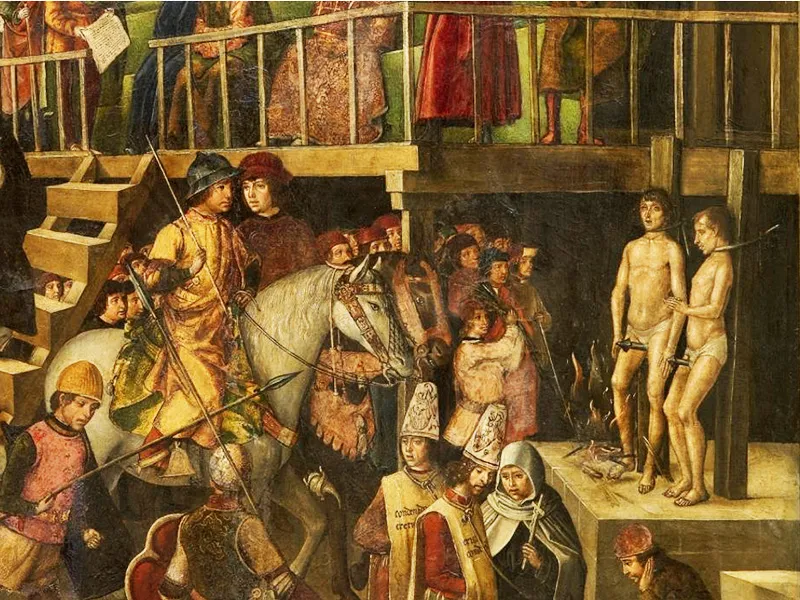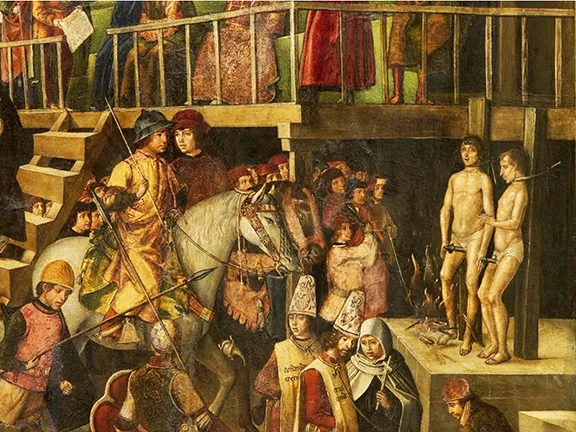Understanding why the Spanish Inquisition happened
By Nick Nutter | Updated 8 Mar 2022 | Andalucia | History |
Login to add to YOUR Favourites or Read Later


Representation of an Auto de Fe
The Spanish Inquisition was by no means the first Inquisition and, by 1478 when it was authorised, the ‘Inquisition’ had already taken on a dark and threatening aura far removed from the original organisation. The term ‘Inquisition’ originally referred to any court process based on Roman Law. Inquisitors applied a judicial process known as ‘inquisito’, that simply means ‘inquire’ or ‘inquest’. The use of the Inquisitional procedure was not confined to the church, monarchs could and did use the process, most famously Henry II of England.
Before 1100 AD, the Catholic Church suppressed heresy through a system of church courts that had the power to forbid individuals from taking part in pagan rituals or other acts deemed by the court to be heretical. Torture was rarely used to extract information. Punishments could be symbolic, such as wearing a badge, a penance such as undertaking a pilgrimage and infrequently, imprisonment.
During the 12th century the Church became concerned about the spread of Catharism, a variation of Catholicism, particularly in France. To combat Catharism and later, other offshoots of Catholicism, the Church set up councils of bishops and archbishops charged with establishing inquisitions the first of which, the Episcopal Inquisition, was set up in Languedoc in southern France in 1184. This was followed by the Papal Inquisition set up in the 1230s by Pope Gregory IX who assigned the inquisitional duties to the Dominican and Franciscan Orders of the Catholic Church.
In 1252, Pope Innocent IV issued a bull, ‘Ad Extirpanda’, that explicitly authorised the use of torture to extract confessions from heretics and by 1256 inquisitors were being given absolution for using instruments of torture.
On the 4th November 1284 Pope Lucius III issued a papal bull, 'Ad Abolendum'. Its chief aim was the complete abolition of Christian heresy. His bishops were obligated to ‘seek out’ heretics by visiting areas where heresy was suspected to flourish, where they would question people about the existence of heresy. People were required to swear under oath anything they knew about heretical activity. All oath breakers and those engaging in heretical activity were to be treated as heretics. The punishment for those heretics who did not foreswear their errors was a loss of rights; the right to hold public office, the right to trial, the right to draft a will, and the loss of hereditability of their fiefs and offices.
In 1320, Pope John XXII gave the Inquisition in Carcassonne permission to ‘prosecute those who worshiped demons, entered a pact with them, made images, or used sacred objects to work magic’. Thereby opening the door to Inquisitional trials for witchcraft. Historically, there is no evidence for Inquisitional witch hunts. In occasional trials the Inquisition defined witchcraft as a combination of sorcery and heresy.
Inquisitions were established in most European countries. By the 15th century, England and Castile were the only large western nations without a papal inquisition. The Inquisitions had no power over people other than Catholics and those who had converted to Catholicism.
Looking specifically now at the Spanish Inquisition we need to look at where the huge numbers of heretics came from that formed the basis for its unenviable reputation, and why the Spanish Inquisition is viewed as a persecution of heretics and Jews.
After the Muslim conquest of Hispania in 711 AD, a small number of Arab leaders and a somewhat larger force of Berbers controlled a native population made up of Visigothic Christians and Jews, both of which were accepted, although with a lower social standing than the Muslims enjoyed. The Jewish populations in particular expanded as they were joined by persecuted Jews from other countries including, at times, the Christian kingdoms in the Iberian Peninsula. Forced expulsions of Jews occurred in England (1290), France (14th century) and Germany (1350s). As the reconquest spread south the civilian population of captured territories found itself under Christian rule.
Until 1146, Jews had generally been accepted within the Muslim occupied territory of al-Andalus. The Almohads, who ruled al-Andalus after 1146, were not as tolerant of non-Muslims as their predecessors and demanded the conversion of Jews and Christians to Islam as a condition of remaining in al-Andalus. Thousands of Jews and Christians moved into the expanding Christian states in the north of the Iberian Peninsula.
Such were their numbers, wealth and influence that, by the early 12th century, the Jews were causing resentment within the Catholic Church in Spain. Church leaders were responsible for measures prohibiting Jews from holding public office, restricting economic activities, preventing Jews having Christian servants and for cancelling royal debts to Jews. Many Jews were pressured to accept baptism. They were called Conversos and were accepted into, or at least alongside, the Christian fold. More importantly Conversos were allowed to retain their previous positions and wealth.
In Spain, towards the end of the 14th century, Ferrand Martinez, Archdeacon of Écija, a vociferous anti-Semite, precipitated anti-Jewish riots in Seville, Cordoba, Valencia and Barcelona. Thousands of Jews were killed and thousands more converted to Christianity, contributing to the numbers of conversos. It is clear however that the nobles and royalty did not support these excesses. In Aragon the ‘governors of the cities, ministers and nobles defended us and many of our brethren took refuge in castles where they provided us with food’ (Reuben ben Nissim 1391).
Following the uprising, the crown of Aragon gave permission for Conversos to revert back to Judaism although most felt it safer to stay a Conversos. This introduced a dichotomy for the Catholic church because Catholic Law forbade forced baptisms and, theoretically, anybody who had been forcibly baptised could revert to Judaism. Legal definitions of ‘forced baptism’ at the time confined this to cases where it had been forcibly administered. Threats of physical violence or death did not fall under the definition. According to Canon Law, Catholics, whether converted or not were forbidden to change their religion. Many of these Conversos and their descendants were still seen as Jews, not practicing Catholics, and, no doubt given the nature of the conversion, many still were.
By 1478, the descendants of Conversos over the previous three hundred years made up a considerable part of the population of the Iberian Peninsula. Many of those Conversos still, secretly practiced their Jewish faith. They were known as Marranos.
By the time the marriage of Ferdinand and Isabella united the kingdoms of Aragon and Castile in 1469, many Jews, Marranos and Conversos had again risen to prominent positions, within the nobility, within government, the royal courts and even in the Catholic Church. Initially, both monarchs were determined to protect their Jewish subjects as well as their Conversos and issued proclamations and intervened repeatedly against municipalities that tried to eliminate the commercial activity of Jews. They were in some respects fighting against a rising tide of anti Marranos feeling. The Marranos were seen as an even greater threat to Christian Spain than those who had refused forced conversion.
Counterbalancing their desire to protect all their subjects, Ferdinand and Isabella had to contend with social tensions and increasingly vociferous anti Jewish groups in the towns. The Christian population hardly discriminated between Jews, Marranos and Conversos. In 1473, Cordoba erupted when mobs took to the streets against the Marranos and Conversos inhabitants of the city. Perhaps not wanting a repeat of 1391 the monarchs decided the only solution was a separation of Jews and Christians.
Uniting their country was a priority for the Christian monarchs. Although the kingdoms of Castile and Aragon were nominally united by their marriage, the nobles of the kingdoms did not always acknowledge the union. Whilst Ferdinand and Isabella were able to raise a formidable army between them that could take on any coalition of nobles, they could not force their will by armed force forever. A Catholic judicial authority was something even the strongest noble could not object to without alienating his own subjects who were, predominantly, Catholic. The Inquisition could be seen as a ‘cross border’ law keeping force governed by a central authority, a point not lost on the Christian monarchs. The question is, did Ferdinand and Isabella intend to expand the scope of its activities beyond heresy once the Inquisition was established?
Ferdinand and Isabella also had to consider how Spain was treated by foreign powers. Alliances between the European powers were becoming more important to maintain balances of power and Spain did not want to be left in the cold, prey to other countries, especially France. Evicting and persecuting Jews and Muslims would allow Spain to show its allegiance to the rest of Europe who had, or were about to, adopt similar policies. (Jews were expelled from Portugal in 1496, Provence in 1512 and the Papal States in 1569.)
Finally, even though defeated, the Muslims were definitely not out. Only a few kilometres across the Straits of Gibraltar, North Africa was a Muslim stronghold. Ferdinand and Isabella were aware that they would be hard pressed to defeat an invading Muslim army, especially if the invaders had a fifth column already in Spain, the Moriscos and Conversos
Ferdinand II of Aragon pressured Pope Sixtus IV to agree to an Inquisition controlled by the monarchy by threatening to withdraw military support at a time when the Turks were a threat to Rome. On 1 November 1478, Sixtus published the Papal bull, Exigit Sinceras Devotionis Affectus, through which he gave the monarchs exclusive authority to establish a Holy Office for the Propagation of the Faith and name the inquisitors in their kingdoms. The first two inquisitors, Miguel de Morillo and Juan de San Martín, were not named, however, until two years later, on 27 September 1480 in Medina del Campo. The Spanish sovereigns had no intentions of turning over to the church the struggle for unity; on the contrary, they sought to use the Inquisition to support their absolute and centralizing regime and most especially to increase royal power in Aragon.